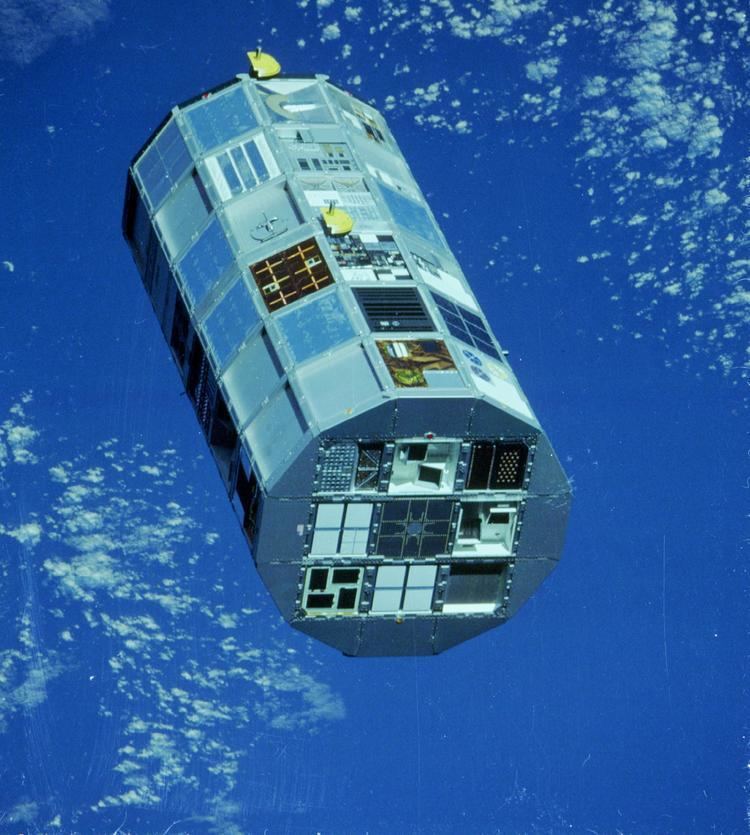Mission type Materials research COSPAR ID 1984-034B Mission duration 2076 days Period 1.6 hours Launch date 6 April 1984 | SATCAT no. 14898 Inclination 28.5° Launch mass 9,700 kg Cost 14 million USD | |
 | ||
Website setas-www.larc.nasa.gov/LDEF/ Similar European Retrievable Carrier, Solar Maximum Mission, Space Shuttle Columbia, Space Shuttle Challenger, Earth Radiation Budget S | ||
NASA's Long Duration Exposure Facility, or LDEF (acronym pronounced "EL-deaf"), was a school bus-sized cylindrical facility designed to provide long-term experimental data on the outer space environment and its effects on space systems, materials, operations and selected spore's survival. It was placed in low Earth orbit by Space Shuttle Challenger in April 1984. The original plan called for the LDEF to be retrieved in March 1985, but after a series of delays it was eventually returned to Earth by Columbia in January 1990.
Contents
It successfully carried science and technology experiments for about 5.7 years, that have revealed a broad and detailed collection of space environmental data. LDEF's 69 months in space provided scientific data on the long-term effects of space exposure on materials, components and systems that has benefited NASA spacecraft designers to this day.
Long duration exposure facility ldef
History
Researchers identified the potential of the planned Space Shuttle to deliver a payload to space, leave it there for a long-term exposure to the harsh outer space environment, and on a separate mission retrieve the payload and return it to Earth for analysis. The LDEF concept evolved from a spacecraft proposed by NASA's Langley Research Center in 1970 to study the meteoroid environment, the Meteoroid and Exposure Module (MEM). The project was approved in 1974 and LDEF was built at NASA's Langley Research Center.
Launch
The STS-41-C crew of Challenger deployed LDEF on April 7, 1984. Attitude control of LDEF was achieved with gravity gradient and inertial distribution to maintain three-axis stability in orbit. Therefore, propulsion or other attitude control systems were not required, making LDEF free of acceleration forces and contaminants from jet firings.
Experiments
The LDEF facility was designed to glean information vital to the development of the future space station and other spacecraft, especially the reactions of various space building materials to radiation, extreme temperature changes and collisions with space matter.
Engineers originally intended that the first mission would last about one year, and that several long-duration exposure missions would use the same frame. The exposure facility was actually used for a single 5.7-year mission. Fifty-seven science and technology experiments – involving government and university investigators from the United States, Canada, Denmark, France, Germany, Ireland, the Netherlands, Switzerland, and the United Kingdom – flew on the LDEF mission. A total of 57 experiments were conducted on the LDEF. Interstellar gases also would be trapped in an attempt to find clues into the formation of the Milky Way and the evolution of heavier elements. Some examples are investigation exposure effects on:
At least one of the on-board experiments, the Thermal Control Surfaces Experiment (TCSE), used the RCA 1802 microprocessor.
EXOSTACK
In the German experiment EXOSTACK, 30% of Bacillus subtilis spores survived the nearly 6 years exposure to outer space when embedded in salt crystals, whereas 80% survived in the presence of glucose, which stabilize the structure of the cellular macromolecules, especially during vacuum-induced dehydration.
If shielded against solar UV, spores of B. subtilis were capable of surviving in space for up to 6 years, especially if embedded in clay or meteorite powder (artificial meteorites). The data may support the likelihood of interplanetary transfer of microorganisms within meteorites, the so-called lithopanspermia hypothesis.
Retrieval
At LDEF's launch, retrieval was scheduled for March 19, 1985, eleven months after deployment. Schedules slipped, postponing the retrieval mission first to 1986, then indefinitely due to the Challenger disaster. It was finally recovered by Columbia on mission STS-32 on January 12, 1990. Columbia approached LDEF in such a way as to minimize possible contamination to LDEF from thruster exhaust. While LDEF was still attached to the RMS arm, an extensive 4.5 hour survey photographed each individual experiment tray, as well as larger areas.
Columbia landed at Edwards Air Force Base on January 20, 1990. With LDEF still in its bay, Columbia was ferried back on the Shuttle Carrier Aircraft to the Kennedy Space Center on January 26. Special efforts were taken to ensure protection against contamination of the payload bay during the ferry flight.
Between January 30 and 31, LDEF was removed from Columbia's payload bay in KSC's Orbiter Processing Facility, placed in a special payload canister, and transported to the Operations and Checkout Building. On February 1, 1990, LDEF was transported in the LDEF Assembly and Transportation System to the Spacecraft Assembly and Encapsulation Facility - 2, where the LDEF project team led deintegration activities.
